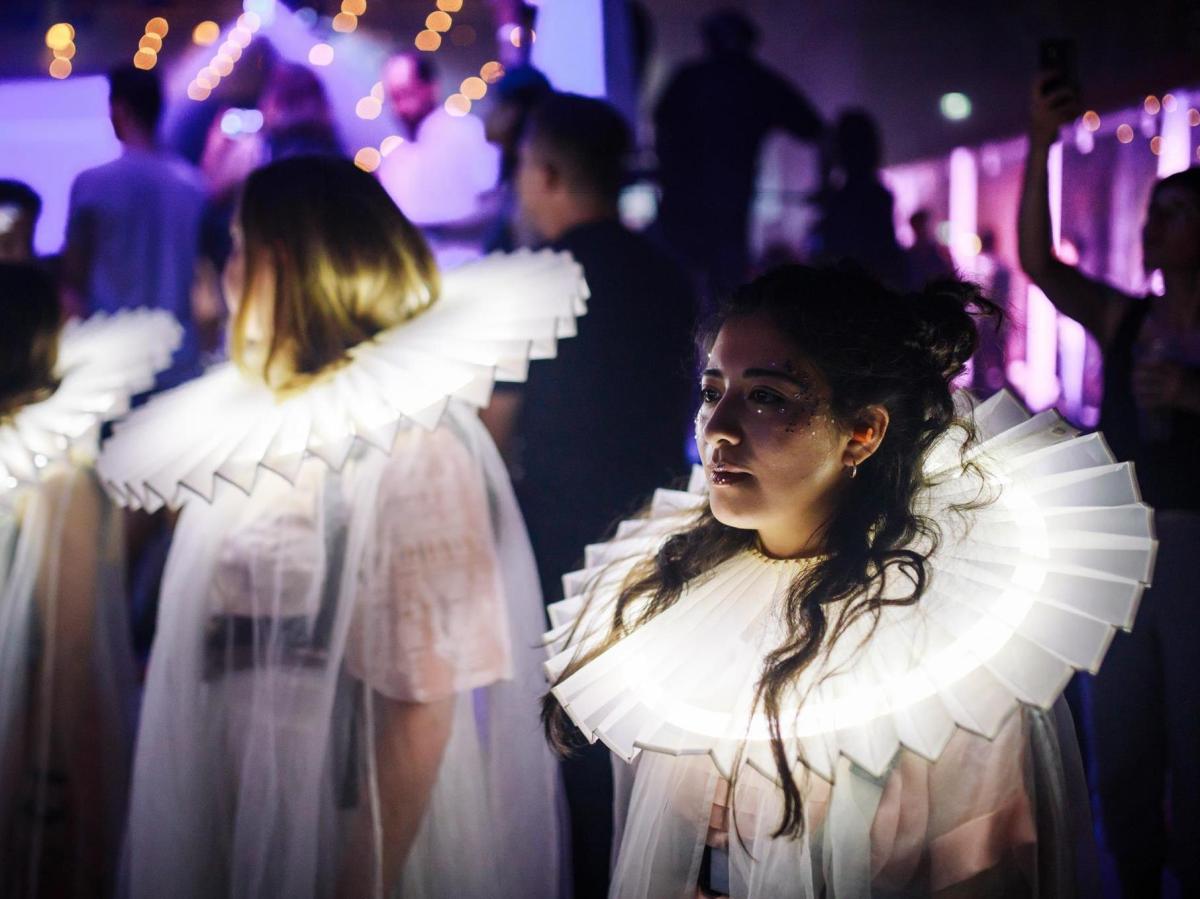Faux Mo: photo by Jesse Hunniford
The Huffington Post recently did a review of festival lineups from the past five years, and found that only 12% of bands featured all-female performers. In a time when music festival bookers are being called out for overwhelmingly programming all-male, all-white bands, MOFO felt like a stride into the future. The stages brimmed with women, with people of colour, with artists singing in dozens of languages to a crowd who beamed back at them.

Photo by Jesse Hunniford
The theme for this year’s festival was ‘Protest’, and the politics of programming were fiercely visible throughout. Every staff member wore a shirt reading ‘All Are Welcome’ in Arabic. The on-site wine bar played music exclusively from countries banned by Trump’s Executive Order #13789, and sold popsicles in the shape of Trump, Stalin, Che Guevara and Pauline Hanson. (We asked one of the staff whether the Trump ones were selling well. ‘No,’ she replied. ‘Nobody wants to lick his face.’). The first thing punters saw on arrival from the ferry was a giant wall with a phone line direct to the White House comment line (overheard messages included: ‘It’s fair, it must be hard to pick up a phone with such small hands’ and ‘Mate, you’re an absolute twit.’). Posters around the festival stated, ‘MOFO is a safe space for people of all identities’ and provided a hotline number for harassment. And the usual festival carpet of plastic plates and cups was avoided simply by not offering them. All the food was served on enamel plates with cloth napkins, which punters dropped back to be washed and reused. Drinks required a $10 deposit for a MONA-branded metal cup, whose nominal value had people clinging to them throughout the festival. As such, come day’s end, the only rubbish left on the main stage lawn was a fine dusting of cigarette butts.
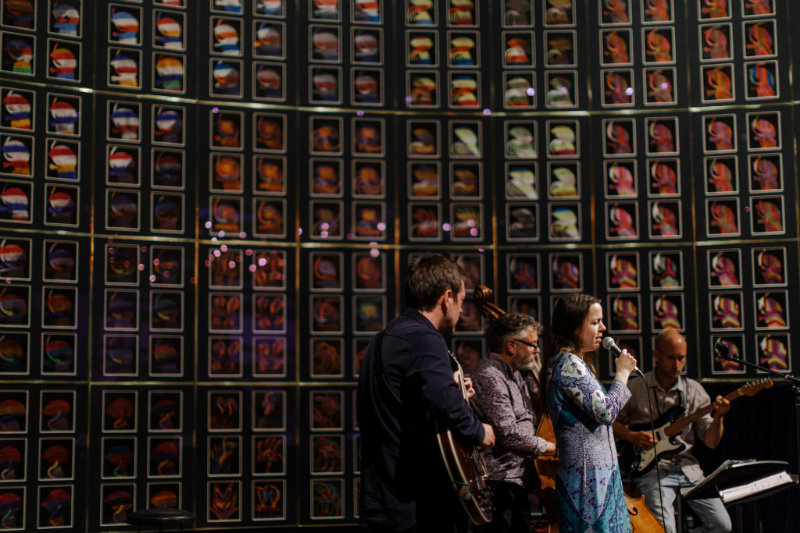
Hobart Liberation Orchestra; photo by Jesse Hunniford
Arriving at MONA necessarily involves a certain sense of ritual – whether by walking the long driveway, flanked by vineyards, or catching the ferry, windswept, eyes fixed on the gallery’s rusted exterior. The descent down the narrow staircase from the building’s ground floor feels like crossing a threshold. One can’t help but feel a little tug of nervous energy.
We entered the museum to find the Hobart Liberation Orchestra in the Nolan gallery, a space beautifully suited to sound, catching it and bouncing it off the huge snake on the wall. People sat on the floor between Jannis Kounellis’ hooks and sacks of coal as jazz noodling meandered into a cover of Midnight Oil’s ‘Beds are Burning’. The room took the wall of brass sound and echoed it back at the band, creating a beautiful legato slip after the staccato notes. Looking upstairs to the next level of the gallery, you could see Pulse, the artwork whose ceiling of light globes synched to the heartbeats of the visitors. For one glorious moment, the lights flashed perfectly in time with the song – a heart beating in perfect rhythm with the music.
Throughout MOFO, the sounds of the gallery’s works bled into performances, making the whole space feel like one huge performed entity. As Maxine Beneba Clarke seared the air with her poetry, the crash of the water in bit.fall filled the silence between a suite of poems, lent voice to the line ‘cold grey lungs, salt-logged, like a Genesis curse’. Applause echoed through the gallery like a sigh, lending a tin-foil percussive roll to music performances.
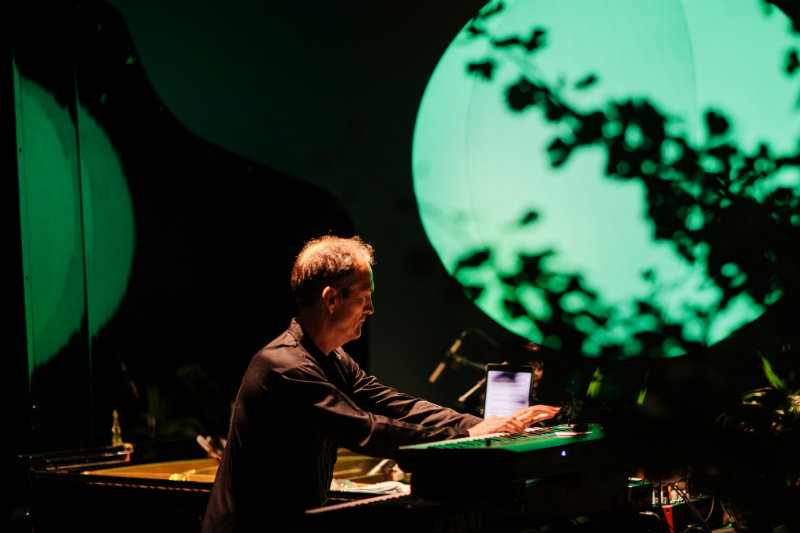
The Green Brain Cycle; photo by Jesse Hunniford
Several works repeated throughout the festival, tucked into rooms in the bowels of the gallery. The Green Brain Cycle harnessed the 60s sci-fi energy of Frank Herbert’s novel. Audience members lolled on shiny gold vinyl beanbags in an astroturf sea, surrounded by plants and lit by a giant green sphere. Michael Kieran Harvey’s composition demanded a deeply physical performance, as he juggled pedals and keyboards. A certain quality of the music brought to mind not only the freneticism of insects, but also the sort of twiddly synthetic keyboard sound that I’ve always associated with daggy school science videos. The vocal distortion on the spoken text, too, felt deeply familiar. I wondered why our auditory shorthand for futuristic inhuman and alien technology always sounds like a chorus of emotionless voices. There’s something there about the fear of the legion, acting in perfect, mysterious unison, a fear that translates well to the source text. The horror of the leaderless unison of insects.
Despite its chaos and energy, the performance was oddly soporific, perhaps because its sound palette was so familiar, so nostalgic and therefore, somehow comforting. Looking around the room midway through the performance, almost all of the audience had their eyes shut. It must be strange to perform to so many people whose condition could be best described as grub-like. Cocooned in sound. Somewhere overhead, applause filtered down, as though bit.fall had released a whole sentence in one go. A sudden crash on the strings of the piano made 40 people jolt awake, blinking in confusion.
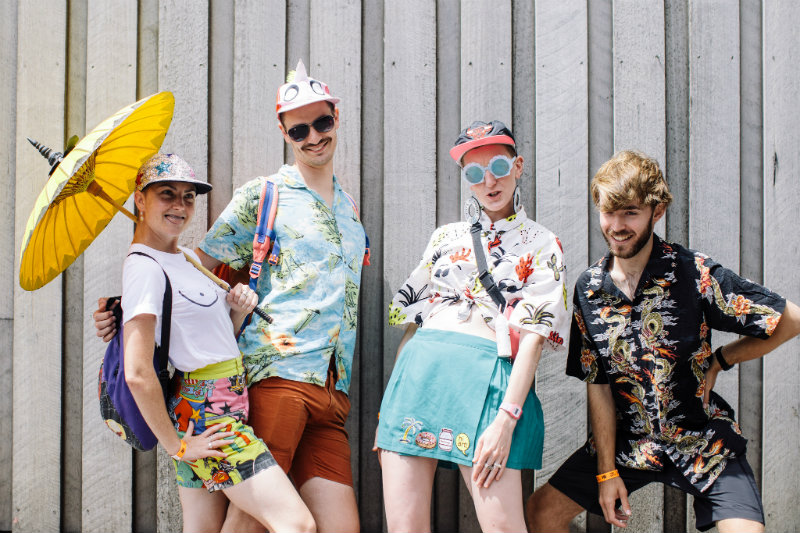
Festival punters; photo by Jesse Hunniford
Giving audience members overly comfortable seating seemed to be a consistently dangerous choice. Stalin’s Piano took place in the Organ Room, which featured a giant circular sofa. Two women to my right lay down, launched into a conversation that I couldn’t help but eavesdrop on (conversation opener: ‘That DJ last night – he was sexy. I’ve got yellow fever. I’m sorry, I wish it weren’t true, but it is’. A few minutes later: ‘I wouldn’t touch a Chinese spring roll, but I love Vietnamese ones.’). Seven minutes later, they were both out cold, open-mouthed. And what a pity for them, because the performance was glorious.
From Robert Davidson’s opening remarks (‘Gough Whitlam speaks mainly in Bb major’), the work evinced a wonderful fascination with the inherent musicality of speech. Sonya Lifschitz provided accompaniment to various historical figures – a rousing underscore to Julia Gillard’s misogyny speech, a touch of the carnival hurdy-gurdy for Donald Trump’s GOP Primary debate footage. Other clips were chopped up and remixed – JFK’s syllables repeated and expanded to draw out the cadences in his speech, Frank Lloyd Wright sampled and distorted. Several of the speakers from the 50s and 60s were so profoundly melodic that they hardly needed accompaniment, and I thought about the etiquette book I once read in the Monash Library Rare Books Collection which taught the reader how to cultivate the ideal laugh – a five-note descending major scale. Such was the skill of the composition and the distraction of the projection that Lifschitz’s playing often faded into the background. It was particularly beautiful, then, to hear her playing Mozart along with a recording of Maria Yudina, Stalin’s favourite pianist, the recording just slightly out of tune with the grand piano in the space, Lifschitz’s playing a touch off being perfectly synched. The effect was one of a sort of temporal slippage, a conjuring of memory, a connection between women across decades.

Eve Klein; photo by Jesse Hunniford
In Eve Klein’s Vocal Womb (almost impossible to get into at every performance, but accessible via a rolling projection at other times), watching Klein’s vocal chords as she sang was a profoundly intimate and surprising experience. The feed from the laryngoscope felt like Jonah’s view from inside the whale, a feeling emphasised by the deep-sea rumble from the mic and the opportunity for audience members to live-mix Klein’s heart, intestines and lung sounds as she sang. There is something deeply counter-intuitive about the mechanics of sound production – watching vocal folds coming together to create the voice. The projected feed somehow rendered the art of opera both unremarkable (suddenly noticeably akin to the rubbing together of a cricket’s legs, or the working of a cane reed) and profound (the extraordinariness of this world of mucus and muscle creating music).
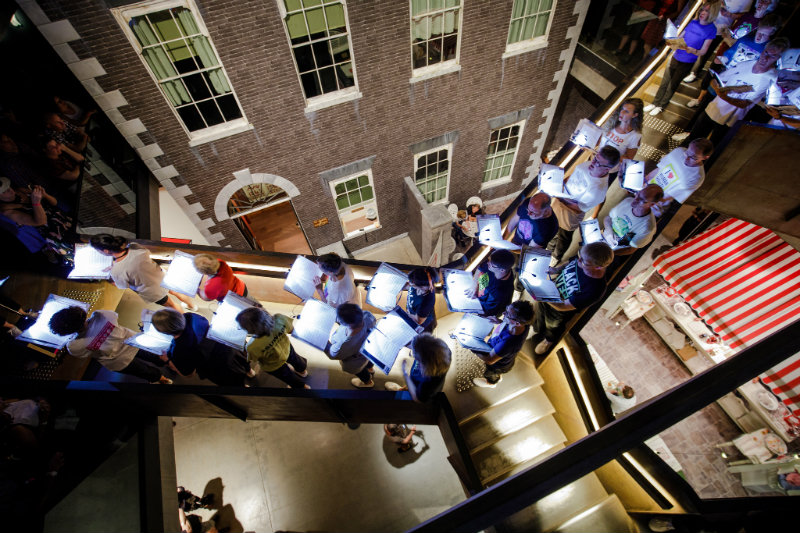
TSO Chorus Extreme; photo by Jesse Hunniford
Spending protracted periods of time downstairs at MONA, getting used to its rhythms, created a certain sensitivity to the movement of people. I realised that the TSO Chorus was about to begin once audience members started moving, without speaking or obvious leadership, trickling through the major gallery spaces like pilgrims. There was that sudden flare of alarm that comes with being swept up in mass human movement that I associate with riots and bomb threats. But when the Chorus gathered on the stairs heading down towards The Museum of Everything, blue lights illuminating their sheet music and protest slogans (‘It’s Time’. ‘Pride.’ ‘Black Lives Matter.’ ‘Indigenous Rights Now.’) across their chests, an expectant hush settled over the people watching from above.
The choral work was beautiful – lush, dense, rising through MONA like a cathedral. People on the bottom floor leaving the Museum of Everything stopped in their tracks and looked up with an expression of profound wonder, as though they’d stepped out into soft-falling snow. They smiled up and we smiled down, beneficent. The Chorus moved underneath bit.fall, stamping together, underscoring a monologue by a 15 year old singer about forced child marriages. These politics felt a little heavy handed, a little oddly placed in and around the music, but the crowd followed them through the gallery, trailing applause.

Fuck the Dots; photo by Sarah Walker
We emerged back into the hot sun of the tennis court to find Adam Simmons playing a shakuhachi, along with a clarinettist and a man who seemed to have recently wandered off a cruise ship (white hair, Hawaiian shirt, boat shoes), playing what sounded like a didgeridoo and looked like some steampunk exploded leather flower-cum-trumpet. As the performance continued, one of the two-dozen or so onlookers let out a loud clap. We turned, only to hear another audience member clapping elsewhere in the crowd. Twelve people then started rubbing their hands together. The crowd whirled around, trying to figure out who was and wasn’t a performer, giggling. It was one of those glorious goosebump-raising moments of realising that you were inside a much bigger work. The audience plants (participants, I suddenly realised, in Simmons’ ‘Fuck the Dots’ workshop) came together, and conducted by Simmons, made monster noises. Simmons turned to the watching audience, standing slightly on their toes like children waiting to be allowed onto a playground. He raised an eyebrow. Then a hand. We all roared. Simmons skipped over. He looked at me (I’ve photographed him before). ‘This is Sarah,’ he said. ‘When she makes this gesture –‘ I hastily waved my hand, ‘then you’re going to yell ‘Where are the dots?’ And you’re going to tell one other person to do the same. Get them to tell someone else, too.’ We scattered across the tennis court.
And this is where MOFO showed a hint of something that came to define the festival – a certain wonderful, unusual lack of cynicism. I don’t think this moment would have worked in Melbourne. Maybe one or two people would have joined in. But at MONA, the tennis court became a scurrying hive of people whispering about the plan. And a minute later, when Simmons gestured to me and I waved my hand in the air, several dozen people yelled ‘Where are the dots?’ The workshop crew yelled back ‘Fuck the dots!’ And we continued, each yelling louder and louder, adding further expletives. Gloriously, as we bellowed ‘Where the fuck are the fucking dots?’ a young boy turned shyly to his mother, and she whispered back, ‘You can join in if you like.’ You’ve never seen a 10 year old happier. Finally, we were all yelling ‘Fuck the fucking dots!’ over and over in the baking sun, lunging forward with each syllable. And then, with a tumble of laughter and applause, we all broke off and meandered away.
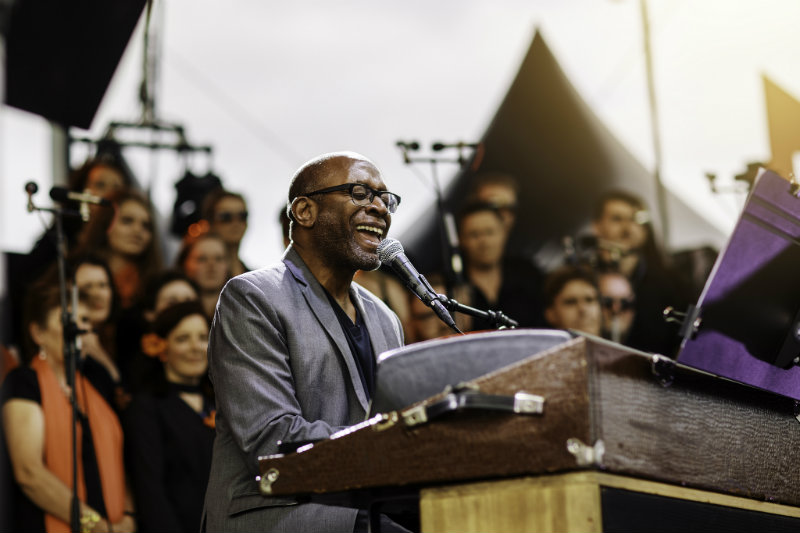
Brian Jackson and the Southern Gospel Choir; photo by Jesse Hunniford
This naked enthusiasm was something that continued to be surprising and delightful throughout the weekend. I bumped into two of the Melbourne PR team who were handling the MOFO marketing. Shaking their heads in wonderment, they told me that one of the news crews had arrived early to shoot footage that morning. When they realised that the other channel hadn’t arrived yet, they’d said, ‘We’ll wait for them to turn up. We don’t want to inconvenience you guys.’ The PR folk were stunned. ‘In Melbourne,’ they said, ‘there’s no way that would have happened.’

Rahim Alhaj and Karim Wasfi; photo by Jesse Hunniford
Audiences seemed actively delighted to be asked to join in. When Rahim Alhaj and Karim Wasfi took to the main stage on day two, the audience (forming colonies in the shade under the scattered umbrellas) responded with gusto to a tricksy clapping rhythm in 10/8 time. Chickens strutted between punters who balanced wine cups between their knees and counted under their breath. When the performers asked ‘You wanna hear fun or tragedy?’, the crowd yelled out, ‘Tragedy!’ and received laughter and an, ‘I love you!’ from the stage.
I happened upon Adam Simmons’ Etude for Disprepared Saxophone twice, watching him smash the shit out of a whole heap of instruments, playing them as they died. The first day, as he lifted a sledgehammer in the air over an alto sax, six women watching all simulatenously hissed under their breath, ‘YES.’ The next day, the crowd was bigger and considerably more upset at the destruction. This time, when the hammer came out, a woman cried out, ‘Don’t do it! What did it do to you?’ Adam grinned back at her. ‘It’s gonna sound different in a moment!’ And when, bleeding profusely down the keys from an errant shard of metal (soon to be patched up, mid-performance, by a security guard), he finally managed to get a sound out of the instrument, the whole crowd cheered.

The People’s Republic of Moorilla; photo by Jesse Hunniford
The MONA staff, too, seemed as fascinated by the works as the punters. One of them put her hand on my shoulder as I gazed at the electronic innards of one of Rosalind Hall and Michael Candy’s music machines and whispered happily, ‘Look! It’s got pride coloured wiring!’ Another, as we stood in James Turrell’s Event Horizon, pointed to the entryway with real joy and told us to watch how the white wall changed colour depending on the LCDs surrounding it. He must have watched that happen hundreds of times, and he was still excited to show it off.
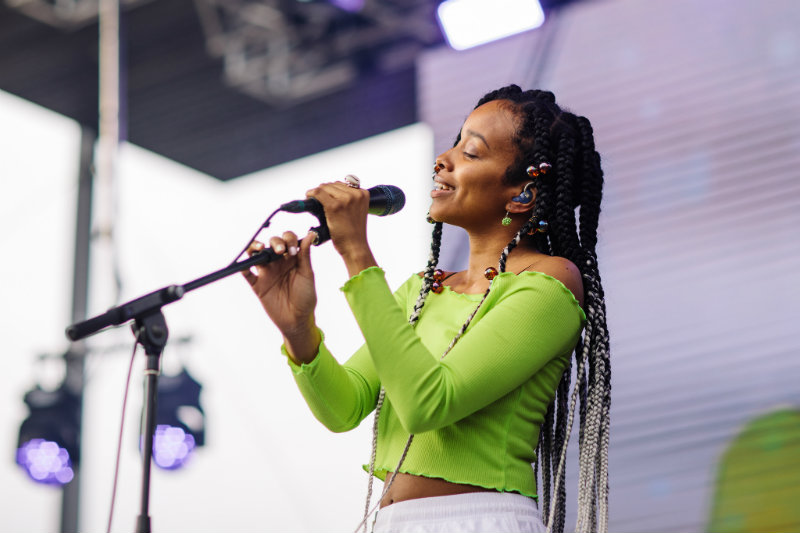
Jamila Woods; photo by Jesse Hunniford
For someone regularly described by the media as ‘reclusive’, David Walsh was everywhere at MOFO – a spectre in loud pants accessorised with a glass of red wine. He was in the crowd at every headliner and most of the smaller performances, dancing with all the finesse of a broken marionette. Most of the festival directors and curators I’ve seen tend to remain in the VIP sections of the actual event, overseeing but not participating. Walsh’s constant loping presence was a pleasant change. He was an especially excellent audience member for Jamila Woods, singing along to Destiny Child’s ‘Say My Name’ and shutting down a blathering couple (pinprick pupils, huge voices) with a crisp ‘Shut. Up.’
The all-ages nature of the festival also provided some delightful juxtapositions. As Woods set hips swinging, a family lounged on a beanbag behind the crowd, the mother staring at her sleeping three year-old in total absorbed wonder. Metres away, a man in his 60s in a striped polo shirt tried out a slut drop for what looked like the first and possibly only time. JLIN played a brutal set on Sunday afternoon, whose sampled screams and harsh trebles felt at odds with the dozy sunlight on the main lawn. While many onlookers sat with expressions of polite discomfort, I watched a father headbanging in time with the beat to entertain his laughing baby, clad in enormous headphones, while a lanky youth skipped across the lawn in time with the sucker-punch bass.

Kardajala Kirridarra; photo by Jesse Hunniford
The programming of a music festival is a delicate thing, and requires a keen sense of rhythm. It’s like making a giant mix CD, couching bolder choices between more palatable favourites. It’s taking the hand of 3000 people and saying, ‘Hey, trust me here.’ And MOFO’s relatively small size meant that Brian Ritchie’s programming had the space to bring fringe acts to an audience who were willing to listen.
Each day rolled into the afternoon with big, bright, poppy performers taking the main stage – Argentina’s Fémina (later seen at The Source restaurant clapping together and singing in harmony, then collapsing into giggles when we applauded), Brian Jackson and the Southern Gospel Choir (featuring the most extraordinary solo from a young indigenous performer who had the crowd in absolute raptures), Kardajala Kirridarra (singing love songs to country with delicious harmonies and bass that set the ground of the stage vibrating) and the bolshy pop-rock of the Black Rock Band.

Turrell Stage; photo by Jesse Hunniford
Ritchie’s programming felt deeply reactive to the physical space of MONA, to the ways in which light changed as the day grew soft. Each evening, crowds wandered from the upbeat rhythms of the main stage to the more intimate Turrell stage, and the energy of the festival softened, slowed. The mountains behind MONA became a huge canvas backdrop for the performers, and it never failed to suit the mood of the acts. During the Daemons of Dissent’s set of folk protest anthems, the world grew flat and misty, like a photo shot on expired film, almost greyscale, so that the pink of the singer’s cheeks seemed almost absurdly saturated.

Breadwoman; photo by Jesse Hunniford
Each night, the second-last set of the day took place at this stage, and provided a breath-in, a moment to regather, to consider and to breathe before the final headline act hit the main stage. This programming demonstrated some real faith in the audience and their willingness to be challenged.
Anna Homler’s Breadwoman Variations took this slot on the first night, a curious work whose elements (toy instruments, bread props) travelled so far into parody that they popped out the other side of ridiculous and became strangely poignant. The audience sat, transfixed, as cycling feedback seemed to slow time. Homler’s mask, bloated and disconcerting, obscured her gaze, and the audience visibly stiffened as she gestured towards them, the tension of a crowd fearing impending participation. I found the work to be lacking in direction, but as it finished, it was to thunderous applause. The woman to my right turned to the man next to her and proclaimed ‘She’s greaaaatschhhhh,’ which is as good a review as any, I suppose.
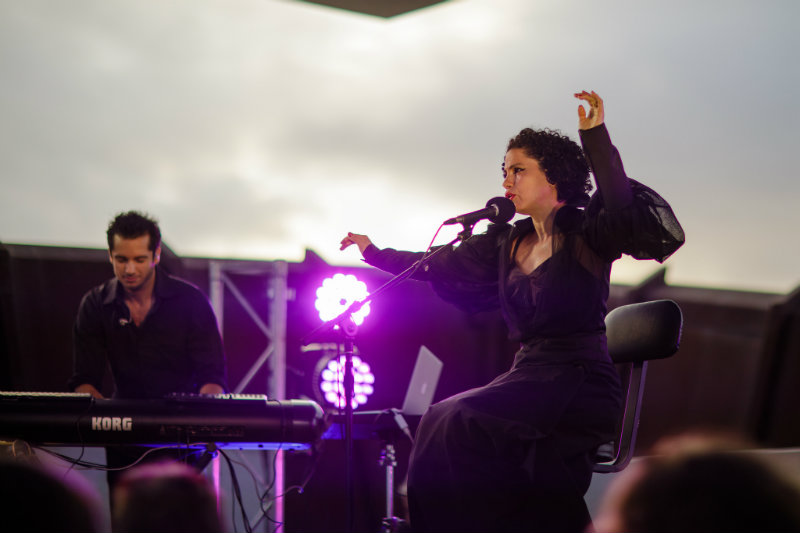
Emel Mathlouthi; photo by Jesse Hunniford
The final sunset of the festival brought Emel Mathlouthi, whose soaring, pure vocals set goosebumps coursing through the seated crowd. As she sang, a single bird wheeled across the sky where clouds smudged the treeline like chalk pastels, and even the most enthusiastic dancers on the sidelines slowly ceased their figure eights and stood in reverent silence. As Mathlouthi swayed past the mic, panning her voice, she tossed her head to the left, and a bird there cried out as though she’d thrown the song up into the trees. Her second-last track was so bewitching that it prompted a whole-crowd standing ovation.
The set finished with a cover of The Cranberries’ ‘Warchild’ in honour of the late Dolores O’Riordan, a rendition whose last acapella notes hung suspended in the air, impossibly exquisite. And then, gloriously, the peahens that had been roaming the gallery site all weekend all started up, sounding like a chorus of broken mattress springs, and the crowd let out a sigh – half laughter, half tears, full of love. Mathlouthi hugged every person who came up to her with damp cheeks, and as David Walsh passed, he said to the woman beside him, ‘Thanks for being here. That ripped my guts out.’
.jpg)
Godspeed You! Black Emperor; photo by Jesse Hunniford
And then, as the sun vanished, the main stage lit up again. Godspeed You! Black Emperor closed the first night, continuing the sense of temporal distortion created on the Turrell stage with a 20 minute bass rumble that slowly, inexorably developed into their first track, building to a place of ecstatic revelation. Their music sounded like the soundtrack to fireworks reflected in water – that same golden, explosive, shimmery quality. It was the sort of music that makes you want to hold someone without talking, the sort of music where everything seems possible and hardship seems beautiful and noble. It was a deeply moving, deeply beautiful set that cast a spell over the gallery and out to sea.

Filistine and Nova; photo by Jesse Hunniford
Filastine and Nova drew the second night audience in with an in-flight video parody (‘You could use your whistle to signal for hope’) and had the crowd in raptures with ‘Drapetomania’: a staggering, airtight experience full of stunning vocals and unsettling bass, backed with extraordinary visuals of a dying world. With Filastine playing trap percussion on a shopping trolley, live dance merged with footage of refugees and rioters to create a rhapsodic space that both reacted against and revelled in chaos and decay, where dissent looked like dance and song felt like revolution.

Mayhem; photo by Jesse Hunniford
The festival closed with a set from Mayhem, early gods of the Norwegian Black Metal scene. Throughout the afternoon, the palette of the festival attendees’ attire drifted increasingly towards black jeans and black tees with thorny white writing. Metal heads wandered quietly through MONA with the diverted eyes of people who are used to being frowned at. The transition from Emel Mathlouthi’s crystal vocals to Mayhem’s chaotic shredding was a jarring one. As the set commenced, I walked past another reviewer, staring pensively at the stage, who sighed, ‘He sounds like he’s having something taxidermied inside him,’ which is one of the better sentences I’ve ever heard a living person utter.
From the vantage of the upstairs cellar door, the band was quite the assault. Whoever was in control of the lighting was doing a stellar job, provided that your measure of success was that the lights should change on every hemisemidemiquaver. It wasn’t until we headed into the crowd and got a good look at the stage that Mayhem began to make sense – though maybe not in quite the same way as they did for the rest of the crowd. Metal, as it turns out, is deeply camp. Drag-show levels of camp. Skulls painted on faces, band members dressed as cowled monks (with the drummer wearing what seemed to be a wimple), four shivering candles crowded around an embarrassed looking skull on a plinth. At the end of the gig, vocalist Attila Csihar bowed to the skull, and in a gesture that had me in fits of giggles, solemnly put out the burning tapers with his palms as the stage lights faded to black. Metal, as it turns out, is deeply silly, though I’m not sure that the acolytes in the front rows, throwing unironic horns in the air and gazing open-mouthed at the band realised it. And given that Mayhem’s early years involved the suicide of their vocalist and the murder of their guitarist by their bassist (who was also linked with a spate of church-burnings), I’m not sure they realise, either.
There seemed something a little uncomfortable about giving the final say of the festival to a group of white men whose history was so distilled by violence. There was a sense of handing over the festival space to another energy, another statement. Perhaps it’s that a band once reviled and feared could find renewed acceptance and admiration – their 2007 album won a Norwegian equivalent of a Grammy, after all. At any rate, the festival’s spirit of protest was alive and well in the pack of young men strolling down the MONA driveway post-show, who, when asked to move out of the way of passing cars by a female security guard, bellowed back, ‘I don’t conform to society!’

Paul Capsis; photo by Jesse Hunniford
This sense of the rhythm of the festival being a little disrupted continued at the nightly official kick-on events. Faux Mo, located in two vast warehouses at MAC2 in the Hobart docks, consistently felt as though it was battling its audience. The programming had moments of real success – Paul Capsis bursting onstage to belt out Nina Simone’s ‘Feeling Good’ surrounded by a posse of fabulous queers being key among them – but there was a constant sense that the stages weren’t quite clicking with their audiences. Partly, it was a function of the shortening of attention span that comes with enthusiastic use of drugs and alcohol. When the queer boat cruise pulled up alongside the venue on Friday night, the crowd turned bleary eyes and cocked heads. When, after a brief and insufficiently amplified dockside performance, the boat headed off to find a landing point, a man turned a beery face to me and asked with droopy-eyed dismay, ‘Is that it?’ When Cakes Da Killa leapt onstage, skipping through songs half-finished and batting away the groping hands of drunk white girls, his good-natured New York sass became increasingly barbed. My friend leaned into my ear and said, ‘I genuinely don’t know whether he’s having a good time.’
Saturday night at Faux Mo saw an average punter age of 18, with all the concomitant awkwardly fitting blazers, boat shoes and total inability to handle substances. I gave up counting the people gone crosseyed on the packed dancefloors, where nobody was dancing to the brutal beats provided by JLIN. Instead, glazed faces were staring with mild terror at the screen full of giant animated octopuses set to motion by live v-jays. By Sunday night, where a much smaller, much more tired crowd strained to hear opera singers over the thumping bass from the next room, it felt as though everyone was just hoping for someone to just start playing daggy 90s bangers. As a MONA staff member I spoke to lamented, ‘I just wanted to come and celebrate by dancing like an idiot.’ The playfulness with form and bold programming that worked so well at MONA didn’t quite translate to the late-night spaces at Faux Mo.

Fémina; photo by Jesse Hunniford
Still, when MOFO worked, it really worked. While the drive and defiance of politics and protest suffused the entire festival, so too did a sense of wonderful connection and delight between performers. It was in the solos traded between Brian Jackson and Andrew Legg, copying each other’s improvisations and developing them (‘Everyone up here is doing this for two reasons: love, and joy’, Jackson proclaimed.). It was in the face of Jamila Woods’ guitarist during her cover of ‘Killing in the Name Of’, pumping out that iconic riff with a huge grin as the crowd cheered. It was the trombonist in the Hobart Liberation Orchestra leaning in to watch the drummer, nodding, smiling. It was a reminder of the power of music to connect players and audience, a feeling summed up perfectly by Fémina on day one, who called out to the crowd, ‘Who doesn’t understand a word of what we’re saying?’ A sea of hands shot up. ‘But who understands the feeling of what we’re singing?’ In response, a deafening roar.
MOFO 2018
Hobart, 19-21 January
